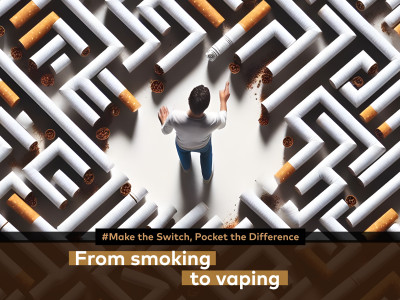Billionaire Michael Bloomberg is funding numerous groups to attack vaping in the United States and further afield, and recently distinguished himself by pretending vaping isn’t safer than smoking.
“Peyton and a group of other chemists discovered almost five years ago that e-cigarettes could sometimes produce more cancer-causing formaldehyde than regular cigarettes,” anti-vape billionaire Bloomberg’s minion opens.
Langreth doesn’t dip into the research itself, but he should have because it makes for humorous reading. Portland State University’s Peyton and Pankow exposed a childlike ignorance of chemistry when, in “Hidden Formaldehyde in E-Cigarette Aerosols”, they applied 5.0V to a top coil CE4 atomiser for 4 second puffs.
If they’d tried doing that, disassembled the atomiser and inspected the wick before going any further they’d have noticed severe scorch marks. Any vaper in 2015 could have told them using a CE4 in such a fashion would have rendered it unvapeable.
Before that, Pankow had already distinguished himself with a now withdrawn attack [defunct link] on vaping and both were prone to cite Bloomberg-funded Tobacco-free Kids fiction from time to time.
So shoddy was this piece of work that advocate Clive Bates commented: “This study is so poorly designed and inherently misleading that it should not have been conducted, should not have been written up, should not have been published in the NEJM or anywhere, should not have been pitched to the media, and its finding should be completely ignored as worthless."
Dr Farsalinos assembled a team and tried to replicate Peyton and Pankow’s findings [link].
Professor Peter Hajek, Director of the Tobacco Dependence Research Unit at Barts, said: “The study went searching for formaldehyde, one of carcinogens that are also present in cigarette smoke. It found it when e-liquid was heated to maximum and drawn via long puffs by a machine. In e-cigarette use by humans, overheating the liquid generates acrid tasting ‘dry puff’, which is unpleasant and avoided rather than slowly inhaled. When a chicken is burned, the resulting black crisp will contain carcinogens but that does not mean that chicken is carcinogenic. Without overheating the e-liquid, no formaldehyde was detected.”
Peyton went on later to express shock at the way his work had been received but acknowledged overheating the coil may have been an issue. Unfortunately, he then went on to postulate that “maybe” formaldehyde was produced at lower voltages and was undetectable by the vaping palate [link].
Like a dog with a bone, rather than step back, Peyton has gone on a quest over the intervening years to discover an irrefutable source of formaldehyde in vapour. Peyton sought revenge on those who slighted his work rather than discover the truth [link].
The Bloomberg article talks about “a swift backlash”, “Bloggers flamed it as ‘bogus’ and ‘invalid.’ The inboxes of Peyton and his colleagues were inundated with name-calling emails.” There is a clear misunderstanding, intended or otherwise, about how scientific work progresses.
And the evidence is that it is intended misunderstanding, because in the next paragraph those highlighting flaws in the study are maligned: “some of them, or their organisations, have received funding that originated from tobacco or vaping companies or vaping advocacy organisations.”
Peyton has now doubled down on his original mistake, clearly noting which way the research funding wind is now firmly blowing in the United States. They “really wanted to kill it,” Peyton tells Langreth. “We had published in this very prestigious journal and used the word cancer and put some numbers to it, and they didn’t like that.”
No, David, they/we didn’t like the amateurish science.
The article warps into nothing more than a hatchet job on Dr Farsalinos and anybody else who peer reviews work in journals. As Peyton say: “The pushback is really significant and really organised. No matter where you are, the same group of people are going to come after you and try to discredit your work.”
It’s not personal, David, it’s science. Peer reviewed science.
Upon publication on the Bloomberg website, Clive Bates commented: “Yes, the Portland ‘Hidden Formaldehyde’ cowboys whining about being criticised for they shoddy methods and outrageous cancer claims. Backed up by equally clueless researchers who made the same rookie errors. Uncritical journalist trying to find a conspiracy where there isn’t one.”
Dr Farsalinos said: “That was the most misleading article ever. E-cigs having 15x the cancer risk of smoking because of formaldehyde levels, this is a double lie:
- Formaldehyde found were due to dry puffs
- Formaldehyde represents only 1% of the total cancer risk from smoking”
Then, he pointed out that the criticism from Dr Khlystov rings hollow given that Khlystov attempted to hide liquids he tested so his work couldn’t be replicated and the findings verified - “But we did it,” added Dr Farsalinos [link].
“Should I offer my apologies to Bloomberg for replicating awful studies that have no connection to the truth? Probably not... They should have known that replication is the ultimate way of validating or rejecting science. None will get away with bad science. That is a commitment!”
Ultimately, Farsalinos sees this article as evidence that he’s doing the right thing, it “makes me feel proud that I am probably doing something right.”
Related:
- “Hidden Formaldehyde in E-Cigarette Aerosols” by Peyton et al. - [link]
- “Scientists Are Working Overtime to Debunk the Vaping Scare”, Bloomberg – [link]
- “The witch hunt against e-cigarettes continues while people get sick from illicit THC and remain uninformed”, Dr Farsalinos – [link]
- “160 Million Reasons To Lie”, POTV – [link]
Dave Cross
Journalist at POTVDave is a freelance writer; with articles on music, motorbikes, football, pop-science, vaping and tobacco harm reduction in Sounds, Melody Maker, UBG, AWoL, Bike, When Saturday Comes, Vape News Magazine, and syndicated across the Johnston Press group. He was published in an anthology of “Greatest Football Writing”, but still believes this was a mistake. Dave contributes sketches to comedy shows and used to co-host a radio sketch show. He’s worked with numerous vape companies to develop content for their websites.
Join the discussion
Ex-WHO Officials Deliver THR Message
Ex-senior officials from the World Health Organization have written to The Lancet to encourage the WHO to embrace the benefits of tobacco harm reduction
Pregnant Adolescents Switch To Vaping
A new study from the University of Buffalo discovered that more pregnant adolescents have switched from smoking to vaping and that it has no negative impact on birth weight
Nicotine Addiction Linked To Brain Grey Matter
Research findings from the University of Cambridge indicates that smoking and nicotine addiction is linked to reduced grey matter in the frontal lobe region of the brain
Rutgers: Ignorance Remains Rife
Rutgers University has conducted a survey looking at attitudes towards vape products and discovered that ignorance about vaping facts remains worryingly high












